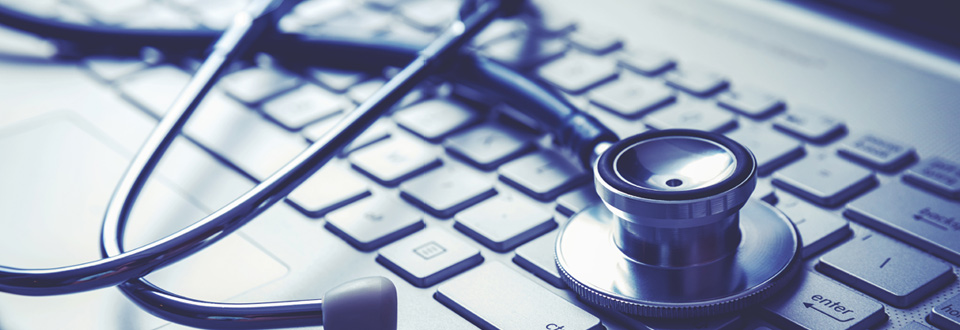
Learn how to develop a cybersecurity plan for your healthcare organization.

Healthcare data is one of the most valuable types of information sold on the black market, and healthcare organizations are prime targets for cyberattacks. Medical records can sell for up to $1,000 because of their sensitive content, such as social security number, date of birth, credit card details, address, emails, and other personal information.
Meanwhile, data security laws such as HIPAA are consistently evolving, making compliance more challenging than ever. As such, every healthcare organization must follow the latest best practices and leverage the newest technologies to strengthen their defense and stay compliant.
Read on to learn the fundamentals of cybersecurity, how healthcare providers have gone awry, what you can do to strengthen your defense, and how to choose the right healthcare cybersecurity partner.

Healthcare cybersecurity is challenging because it requires a specialized approach to protect sensitive medical information exchanged between multiple systems and devices within and outside of an organization.
Cybersecurity in healthcare focuses on safeguarding protected health information (PHI). A comprehensive healthcare cybersecurity program must protect all patient data kept across an organization's various information technology systems.
These include electronic health record (EHR) systems, email clients, medical devices, wearables and other patient monitoring devices, phone systems, other software and legacy systems, printers and fax machines, instant messaging tools, and other communication applications.
Healthcare cybersecurity also protects other sensitive data, such as financial documents, personnel files, and vendor contracts.
After several significant data breaches, the Cybersecurity Act of 2015 (CSA) was created to enhance healthcare security. Since then, healthcare cybersecurity has become increasingly essential for both day-to-day operations and delivering high-quality patient care. Furthermore, the skyrocketing costs of data breaches have made healthcare cybersecurity a critical investment.
Meanwhile, maintaining healthcare cybersecurity has become harder as criminals have become more sophisticated in their approach and increased the frequency of their attacks. Most recently, hacker conglomerates such as the Conti group took advantage of the pandemic to target overburdened healthcare organizations.
Today, the top cybersecurity risks include email phishing, ransomware attacks, loss or theft of hardware, and attacks against medical devices.
Healthcare cybersecurity can be an overwhelming topic. Understanding these key terms and what they mean for a healthcare organization can help you make informed decisions:
A data breach happens when data is accessed without authorization or the knowledge of the system's owner. Healthcare data breaches are on the rise, with more than 600 reported healthcare data breaches affecting over 26 million individuals in 2020.
A cyberattack is an attempt to gain unauthorized access to a system or information network to change, steal, view, or disable data. To protect your organization, you must implement procedures for ongoing testing, improvements, and optimization.
Cybersecurity is the practice of protecting information systems and data from unauthorized access, theft, or loss. Healthcare cybersecurity isn't just an IT problem—it's a major operational and financial concern. A data breach can cost as much as $499 per compromised record, in addition to the loss of patient trust and the damage to your reputation.
Data encryption encodes information such that only users with the key can decrypt it. The data will appear unreadable to anybody who isn't the intended user. Hardware containing unencrypted patient data accounts for approximately 60% of healthcare data breaches. In fact, HIPAA recommends that all critical patient information be encrypted at all times.
A firewall is a line of defense between the internet and your computer systems. You can determine which data should be allowed in and out of your network. To remain HIPAA compliant, you must record all attempts to access your network. This will also help you detect suspicious behaviors.
Cybersecurity only concerns digital information, while information security involves safeguarding all types of sensitive data. This can include patient records on paper, medical device printouts, or equipment such as hardware and printers.
Malware is a software program criminals use to commit cybercrimes. Ransomware is one of the most prevalent types of malware that affects the healthcare industry. When ransomware infects a computer network, it locks out authorized users from accessing system data. Cybercriminals would then demand money to release the information.
Patches are upgrades to applications and hardware that developers release between new versions. These patches often fix bugs and security flaws. You must keep all your systems and software programs up-to-date, particularly anti-malware and anti-virus solutions, so cybercriminals can’t exploit the vulnerabilities to breach your network.
Cybersecurity for healthcare is essential in today's digital environment. Here are six reasons why healthcare providers must make cybersecurity a top priority:
A cyberattack on a healthcare organization can give hackers access to sensitive personal information that is highly sought after on the black market. Criminals may also use the data for various fraudulent purposes, putting patients at risk of financial, reputational, and other losses.
Malware or ransomware attacks can cause you to lose access to medical records and medical IoT devices, jeopardizing your ability to provide care and guarantee patient safety. Not to mention, hackers who break into your EHR system might intentionally or unintentionally change patient data, resulting in life-threatening mistakes and poor treatment outcomes.
Patients want to know that you will keep their personal information secure. Therefore, you must establish credibility to attract and retain patients. A data breach can damage your reputation, which may have a long-term impact on your patient acquisition and retention efforts.
Criminals can use stolen patient data to commit healthcare and insurance fraud. Your patients may suffer the consequences of identity theft, and your organization could incur financial losses and reputation damage. Widespread fraud will also impact the healthcare sector by driving up insurance premiums and overall operational expenses.
A poor cybersecurity posture might result in a HIPAA violation and a hefty fine. Whether the breach is intentional or unintentional, failing to follow HIPAA privacy, security, or breach notification rules may result in a $50,000 or more penalty.
Proper cybersecurity measures can help you detect or prevent a breach in a timely manner. Having the right process in place can help you avoid unnecessary downtime, revenue loss, costly remedial actions (e.g., providing credit monitoring to affected patients,) legal fees, and a lengthy data recovery process that could affect patient care.

Many data breaches in the healthcare industry are caused by human errors and misconceptions about cybersecurity. Here are some mistakes you should avoid.
Here are four misconceptions that cause common mistakes made by healthcare practices and how you can prevent them.
Some practices assume that hackers target only large businesses such as hospitals, health systems, and major healthcare software vendors. But that’s far from the truth. One in three healthcare data breaches affects smaller organizations, such as physician practices and ambulatory surgical centers.
A few factors make smaller organizations easier targets for cybercriminals. They may struggle to stay current with the newest threats and issues, have trouble selecting suitable cybersecurity solutions, and have small cybersecurity budgets.
You can effectively protect patient data if you take cybersecurity for healthcare seriously, even with a modest budget. Implementing HIPAA standards is a good place to start. Use this HIPAA compliance checklist to help you reduce the risk of data breaches and stay HIPAA compliant.
Healthcare practices are busy, so it's no surprise that security updates aren't always at the top of the to-do list. However, technology is shifting rapidly, and cybercriminals are constantly using new techniques to breach networks.
Software vendors frequently release security patches and upgrades to counter cybercrimes. Applications that aren’t patched promptly are more vulnerable to cyberattacks and data breaches.
Implement a procedure for updating software regularly and confirming that the patches are installed correctly. Regular security checks aren't only necessary for HIPAA compliance—they're also an excellent method for uncovering outdated patching and updates that could make your organization vulnerable to attacks.
Healthcare organizations are particularly susceptible to data breaches caused by human error. In fact, the most common cause of data compromise continues to be mistakes in delivering electronic and paper documents.
Many practice managers make the mistake of assuming that annual compliance training is sufficient. But cybersecurity for healthcare is complex and fast-changing. An annual training event is simply not enough to keep your healthcare data safe.
Instead, you should establish a "risk-aware culture." Train employees to detect and respond to cyberattacks. Run security awareness campaigns regularly to ensure that everyone in your organization stays current with the latest cybersecurity best practices and compliance requirements.
Hardware, such as computers, laptops, and tablets, can pose significant risks to healthcare cybersecurity. Security upgrades may no longer support older devices, creating an exploitable vulnerability.
Meanwhile, the longer a device has been on the market, the more time cybercriminals have to discover security flaws they can exploit. Laptops, tablets, and flash drives are particularly vulnerable to physical theft. Also, many individuals don't know how to properly scrub and dispose of hardware containing patient data, putting the information on these devices at risk after the devices are no longer in use.
You can switch to a hardware-as-a-service (HaaS) model instead of buying hardware on an as-needed basis. Your managed services provider (MSP), such as Medicus IT, will handle all your hardware upgrades and perform maintenance and management of all devices.
Understanding the common causes of healthcare data breaches can help you take the necessary precautions to safeguard your sensitive patient information. Here are five mistakes you should look out for:
Healthcare organizations are particularly vulnerable to phishing, one of the most frequent methods cybercriminals use to breach a network. Scammers send emails that appear to be from a trustworthy source to trick employees into providing their access information.
Provide employee training to help your staff detect and avoid email scams. A security awareness phishing campaign can give you the information you need to identify vulnerabilities and improve employee training.
Failing to encrypt electronic PHI (ePHI) is a major concern in the healthcare industry. Lost or stolen devices that hold unencrypted patient data are responsible for over 60% of all significant healthcare cybersecurity breaches.
To minimize the risk of exposing unencrypted data, audit of your patient data systems and identify those that don’t have encryption. Upgrade to a version with encryption capabilities or move to a new software platform with the necessary security features.
Too often, healthcare providers create a security risk when they fail to permanently delete patient records that are no longer needed. These can include physical and digital files containing patient information such as names, addresses, social security numbers, and insurance information.
Implement appropriate policies and processes to ensure the safe disposal of patient information. Document all computers and equipment that stores patient data and follow HIPAA-compliant procedures to dispose of them when they’re no longer in use.
Many healthcare providers fail to implement controls to limit who can access sensitive data—making it very easy for hackers to steal patient information. You should implement two-factor authentication (2FA) to add an extra level of protection to your ePHI and keep an audit log to track who has accessed patient data.
Meanwhile, HIPAA rules require healthcare organizations to install an automated log-off function on any device with access to patient information. Taking this step can help minimize the risk of cybersecurity breaches due to a simple oversight of forgetting to log off.
Many organizations make the mistake of assuming that cybersecurity is a one-time event rather than viewing it as an ongoing set of systems, processes, and training. Vulnerability can also occur if you change your IT system, hire new employees, and modify operational procedures without updating security configurations.
Regular security assessments can help prevent attacks caused by outdated systems or incorrect procedures. Conduct a thorough security risk assessment to examine your entire patient data infrastructure and identify potential areas so you can address them promptly.
Cybercriminals are constantly coming up with new ways to infiltrate systems and steal sensitive information. By examining the latest healthcare data breaches, you can watch for signs of potential threats and better protect your sensitive patient information.
Here are five of the top healthcare data breaches in 2020:
In May 2020, the cloud computing vendor's self-hosted environment was infected by malware. Although Blackbaud detected the breach in time to prevent the cybercriminals from encrypting the whole network, a portion of the data was stolen.
The eyecare company suffered two security breaches in 2020. After a ransomware attack, unauthorized persons hacked into the firm's web-based appointment scheduling software in August.
The attackers continued to leak business-critical information they obtained from Luxottica over the next several months, including banking and other sensitive data. It should be noted that the hackers aren't just profiting off the stolen data—they're also trying to scare future victims into paying the ransom.
During a month-long assault, cybercriminals hacked Dental Care Alliance's (DCA) system to steal sensitive data from more than 320 dental practices in 20 states. The incident compromised around 1 million patients' personal information, including names, contact details, account numbers, bank account information, and health insurance data.
When a laptop was stolen from a vendor of Oregon's largest Medicaid coordinated care organization, 654,000 patients' PHI was exposed. The incident highlights the importance of including physical security measures in any healthcare cybersecurity plan.
The breach also demonstrated that even one stolen device can lead to substantial damages. Organizations must undergo regular HIPAA cyber security risk assessments to identify risks and vulnerabilities that may put PHI and other sensitive data at risk.
In September 2020, a cyberattack on the behavioral and mental health institution's IT infrastructure resulted in the theft of around 296,000 patient records. AspenPointe had to shut down most of its operations for several days as a result of the incident. The information exfiltrated included social security numbers, birthdays, driver's license numbers, and bank account details.

Healthcare organizations that suffer a data breach could face state and federal penalties and incur the high costs of risk mitigation for victims. A data breach might cause a healthcare provider to cease operations for days or even go out of business.
Follow these six healthcare cybersecurity best practices to strengthen your defense against cyber threats.
A cybersecurity plan is only as effective as its weakest link, which is usually your staff. It takes only one employee to click on a malicious link to bring down the entire network. As such, employee training is key to maintaining a strong cybersecurity posture.
A security awareness phishing campaign tracks how your staff responds to phishing scams. You may use the opportunity to share the results and teach employees how to identify and report suspected phishing attempts. Regular education keeps cybersecurity top of mind, making your staff less likely to fall prey to similar attacks.
Per HIPAA guidelines, every healthcare provider must conduct security risk assessments. These evaluations analyze your IT environment and identify vulnerabilities so you can address them as soon as possible to remain HIPAA compliant.
Aside from your IT infrastructure and network, you should evaluate the security posture of your suppliers and business partners, employee training and education program, and backup and recovery plan. Then, use the assessment report to help you make improvements, implement corrective actions, and upgrade your IT infrastructure.
Healthcare facilities' digital credentials (e.g., username and password for accessing your system) are some of the most sought-after assets on the dark web. If your employees’ login information falls into the hands of malicious actors, you're more likely to experience a data breach.
Conduct regular dark web scans to identify compromised credentials. Then, change them or delete the associated accounts to prevent unauthorized access. Also, find out how your information ended up on the dark web to inform your future staff training and security measures.
Two-factor or multi-factor authentication (2FA or MFA) requires users to supply two or more pieces of information to authenticate their identities before connecting to your network. These can be a username/password, a PIN, a code sent via SMS, and a fingerprint scan.
Most reputable cloud software providers already offer a 2FA feature, so make sure to turn it on. Meanwhile, a healthcare IT specialist can help you set up 2FA or MFA according to HIPAA requirements for your network.
Cloud computing can help you improve your cybersecurity posture. Most HIPAA-compliant cloud providers have a team of security experts dedicated to protecting your data. You won't have to worry about maintaining and upgrading the software or server that processes and stores your critical information.
An experienced healthcare cloud services vendor can help you move your IT infrastructure and data storage to the cloud. It can also create a plan for maintaining data security through ongoing risk management and IT policy implementation.
Ransomware attacks or security breaches may result in data loss and even paralyze your operations. You should implement a comprehensive backup and recovery strategy to ensure business continuity and resilience.
Most cloud software platforms offer data backup and recovery features to safeguard customers' data. You can also encrypt and store your data in a HIPAA-compliant cloud server. The backup server should be physically separated from your production systems and reside in a different geographical location.
Staff training and education are essential for any effective healthcare cybersecurity strategy. Here’s why you should invest in cultivating a security-ware environment:
As noted earlier, employees are often the most vulnerable component of a healthcare cybersecurity strategy. In fact, human errors are responsible for 90% of data breaches.
You can prevent human errors by providing appropriate employee cybersecurity training on phishing prevention, password best practices, and the correct ways to store and share confidential patient information.
Employees may require access to patient data from home or while traveling. Staff members who aren’t trained in HIPAA-compliant practices may not know how to maintain safe practices while using their own devices.
Establish security procedures for all devices and offer training to ensure HIPAA compliance when staff access your network remotely. Off-site employees should receive training on how to keep patient information safe. Unless these employees have HIPAA-compliant methods for disposing of printed information, the printing function should be disabled.
Phishing incidents in 2020 nearly doubled in frequency compared to the year before. There were 11 times more phishing incidences in 2020 than there were in 2016.
You must ensure that your staff can recognize and avoid falling victim to phishing attempts. A security awareness phishing campaign is one of the most efficient ways to educate employees about cybersecurity. You can then offer targeted training to strengthen your defense based on the results.
While preventing data breaches should always be the top priority, you must also be fully prepared for one if it occurs. An effective incident response process can help minimize downtime, damages to your reputation, and the cost of remedial actions.
You must have a formal, written incident response plan and train your staff to implement it. Educate your employees on the many types of breaches, how they happen, and the procedure for reporting suspicious activities or incidents (e.g., unauthorized access, data breach).
Healthcare cybersecurity training not only keeps your patient information safe but can also help you avoid HIPAA non-compliance and fines. Under the HIPAA Security Rule, all members must complete a "security awareness and training program.”
The HIPAA security standards do not specify the type of education employees must receive due to the wide range of healthcare organizations covered by the regulations. You should first conduct a HIPAA security assessment to identify the key areas to focus on when planning your cybersecurity training.

For many healthcare organizations, building and maintaining a large in-house IT team with the expertise needed to support a robust cybersecurity program is simply not practical. That's why more savvy providers work with healthcare cybersecurity services providers to improve their security posture and ensure HIPAA compliance.
A competent, experienced healthcare cybersecurity service provider offers a wealth of expertise, services, and solutions. This includes the most up-to-date knowledge on cybersecurity threats and best practices, as well as specialists who can help you implement cybersecurity best practices.
Here are the benefits of working with experts in cybersecurity for healthcare:
HIPAA compliance is complex. Even with an in-house IT department, many healthcare organizations struggle to implement all of the security measures required to keep patient health information (PHI) secure.
A healthcare cybersecurity firm understands the ins and outs of HIPAA requirements. It has the processes to execute the required assessments, create the necessary documentation, and implement remediation actions. The knowledge ensures that your facility not only meets compliance standards but also stays compliant year after year.
Healthcare cybersecurity is a highly specialized area. The newest technologies and solutions are only as good as the people behind them. A healthcare cybersecurity services company has teams of experts to help you implement the latest security measures, techniques, and procedures.
They will also keep a close eye on your IT infrastructure and systems, alerting you to early signs of an attack, and assist you to minimize the impact of cybersecurity incidents and costly downtime.
Most healthcare organizations can’t afford to purchase and implement all of the tools they need to address their cybersecurity vulnerabilities. A healthcare cybersecurity service company can give you access to cutting-edge hardware and software at a fraction of the cost.
A provider can integrate these capabilities in a coordinated approach to maximize their effectiveness. It can also use automation technologies to monitor network activities and respond to threats faster and more systematically.
You can get a thorough assessment of your IT infrastructure when you work with a healthcare cybersecurity services company. Experts will help you identify cyber risks, deploy resources strategically to strengthen defenses, and eliminate security blind spots in your network.
Your vendor partner can also help you establish a data backup and recovery plan. Even if you are the target of a cyberattack, you can maintain business continuity and minimize losses. Finally, the right partner can help you create effective short- and long-term information security strategies.
Healthcare organizations are often caught off guard by cyberattacks, and delayed responses can lead to dire consequences. A healthcare cybersecurity services provider can help you develop an incident response plan to outline the correct actions when suspicious activities are detected.
Plans often map out employee action items, professionals to contact, legal and insurance responsibilities, and communication strategies for notifying patients and the authorities.
Cybersecurity and compliance require round-the-clock efforts. Managed security services offer 24/7 protection to ensure that your system is monitored by cybersecurity experts at all times. You'll get alerts of suspicious activities and monthly analytics to give you a complete view of your systems and network.
Here are four areas where top healthcare organizations invest time and money to defend themselves against cyberattacks and prepare for potential breaches—and what you can learn from them.
Perform risk assessments to identify vulnerabilities and areas for improvement. A general security risk assessment, vulnerability audit, and business impact assessment should be part of this evaluation. You should also conduct a dark web scan and penetration testing, a form of ethical hacking that tests your security systems to identify where you should invest in upgrades.
Have your security assessments performed by an external IT firm with experience in the healthcare sector. Such expertise helps reduce the risks of overlooking vulnerabilities, which is common when an in-house IT team performs an assessment. Additionally, an expert provider can help you update your data security policies to stay current with compliance requirements.
Well-prepared healthcare organizations invest not only in data security technologies but also staff training and education. After all, human errors are responsible for the majority of breaches.
Frequent refresher courses on the fundamentals of healthcare IT security should be part of your healthcare cybersecurity strategy. Also, train your staff on updated cybersecurity protocols when you implement new systems or operational procedures.
Even though your competitors may be slow to implement new technologies, it shouldn’t be reason to not pursue the latest security protocol. For example, even small healthcare organizations use cloud computing to improve business continuity and disaster recovery preparedness while strengthening their security posture.
Another example is two-factor authentication (2FA), a security measure in which users are required to provide two pieces of security data before they can access sensitive information. This simple security measure can deter hackers from using stolen credentials to infiltrate your network.
The healthcare cybersecurity landscape is challenging. You should work with IT specialists who have unique insights into the many aspects involved in developing and maintaining a best-in-class cybersecurity program for healthcare organizations.
In fact, most healthcare organizations, especially those with 200 or fewer employees, find that they can best meet their cybersecurity and compliance requirements by working with an IT services provider with extensive healthcare cybersecurity experience and expertise.
Healthcare cybersecurity companies can help companies strengthen their defense and stay HIPAA compliant using a variety of approaches. Here are the most critical healthcare cybersecurity services to look for when partnering and ways these services can help protect your data.
Keeping up with the latest cybersecurity best practices and regulatory compliance is an ongoing effort. When you partner with a healthcare cybersecurity company, you’ll gain access to a team of cybersecurity experts who will monitor your system, recommend services as needed, and respond to alerts around the clock.
Cyberthreats against the healthcare industry will continue. It’s not a matter of “if” but “when” a hacker will try to infiltrate your network.
Healthcare providers must go beyond defensive cybersecurity strategies, extending efforts into preventing attacks and incorporating cyber resiliency into their strategies to ensure that they can recover quickly from one.
With so many areas to address, it has become increasingly challenging to get all the bases covered. Doing everything in-house—hiring an expert team, purchasing all the technologies, and continuously monitoring all the systems—is simply too costly and inefficient for most providers.
That’s why savvy healthcare organizations partner with experienced and reputable healthcare cybersecurity companies to help them strengthen their defense and stay HIPAA compliant.
Here at Medicus IT, we treat cybersecurity as a top priority 24/7/365. We combine a strategic focus on systems and solutions to help healthcare organizations stay out of trouble and keep patients out of harm's way. Meanwhile, our incident response and remediation planning ensure that our clients can respond quickly and effectively if they experience a cyberattack.
Learn more about our comprehensive healthcare IT security and compliance services and see how we can help.

Sign up to receive emails and stay up-to-date with the latest IT news and innovations in the healthcare industry.